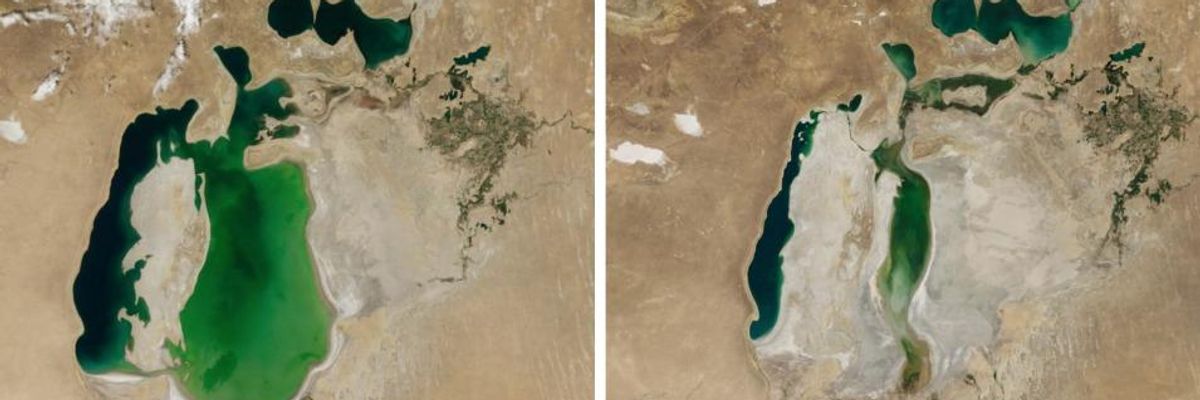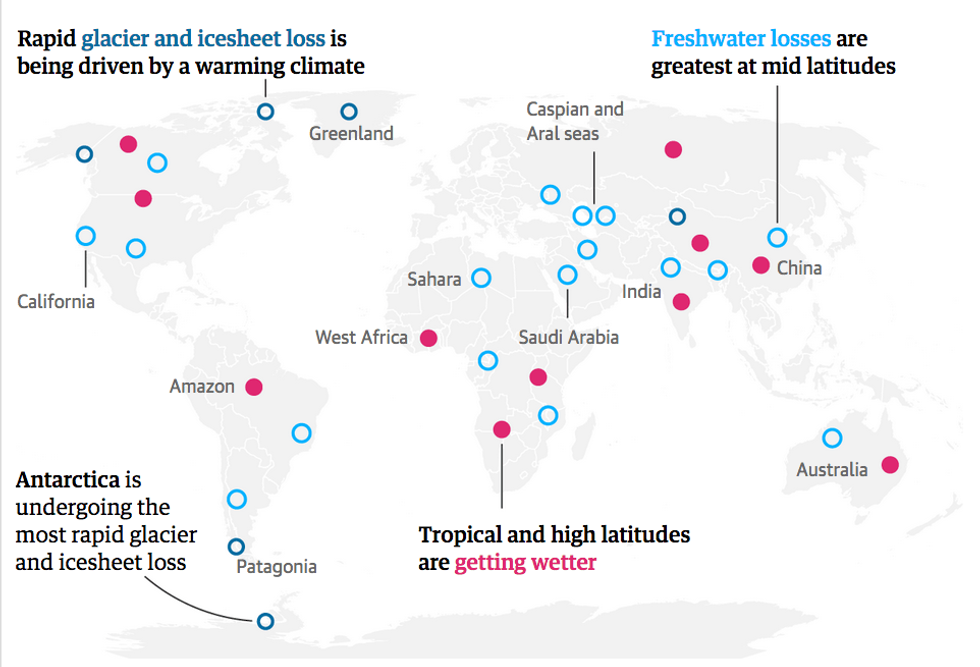

SUBSCRIBE TO OUR FREE NEWSLETTER
Daily news & progressive opinion—funded by the people, not the corporations—delivered straight to your inbox.
5
#000000
#FFFFFF
To donate by check, phone, or other method, see our More Ways to Give page.


Daily news & progressive opinion—funded by the people, not the corporations—delivered straight to your inbox.

The Aral Sea, seen in a NASA satellite image, in 2000 on the left versus 2017 on the right. (Image: Modis/Terra/NASA)
With a first-of-its-kind satellite study, NASA scientists have identified more than 30 parts of the globe where the depletion of freshwater has been most dramatic, largely due to human activity and the climate crisis.
Parts of India, the Middle East, Australia, the Arctic, Antarctica, and California were among the places pointed out in the new study published in Nature on Wednesday, as areas where an overuse of groundwater resources from irrigation, agricultural, and industry projects, as well as the loss of glaciers and ice sheets, have led to water shortages.

The findings showed a "clear human fingerprint" on the drying out of the Earth, the authors of the report told the Guardian.
\u201cEarth\u2019s wet areas are getting wetter and dry areas are getting drier due to a variety of factors, including human water management, climate change and natural cycles.\u201d— NASA Earth (@NASA Earth) 1526492898
Aside from the warming planet's effect on rapidly melting polar ice, the extraction of water from rivers like those that feed into the Aral Sea in Central Asia, for the purposes of farming and industrial use, have resulted in dramatic losses of freshwater.
Over-extraction has been especially problematic in parts of India and China, according to the study, causing a rapid decline in the availability of water despite normal rainfall levels.
"The fact that extractions already exceed recharge during normal precipitation does not bode well for the availability of groundwater during future droughts," wrote the study's authors.
"This report is a warning and an insight into a future threat," Jonathan Farr of the charity WaterAid told the Guardian. "We need to ensure that investment in water keeps pace with industrialization and farming. Governments need to get to grips with this."
The worst-affected regions were uninhabited parts of the globe like Antarctica where 10 percent of the icy continent's glaciers are now in retreat, according to a study published last month.
\u201cFreshwater is present in lakes, rivers, soil, snow, groundwater and glacial ice. Its loss in the ice sheets at the poles -- attributed to climate change -- has implications for sea level rise.\u201d— NASA Earth (@NASA Earth) 1526492898
Trump and Musk are on an unconstitutional rampage, aiming for virtually every corner of the federal government. These two right-wing billionaires are targeting nurses, scientists, teachers, daycare providers, judges, veterans, air traffic controllers, and nuclear safety inspectors. No one is safe. The food stamps program, Social Security, Medicare, and Medicaid are next. It’s an unprecedented disaster and a five-alarm fire, but there will be a reckoning. The people did not vote for this. The American people do not want this dystopian hellscape that hides behind claims of “efficiency.” Still, in reality, it is all a giveaway to corporate interests and the libertarian dreams of far-right oligarchs like Musk. Common Dreams is playing a vital role by reporting day and night on this orgy of corruption and greed, as well as what everyday people can do to organize and fight back. As a people-powered nonprofit news outlet, we cover issues the corporate media never will, but we can only continue with our readers’ support. |
With a first-of-its-kind satellite study, NASA scientists have identified more than 30 parts of the globe where the depletion of freshwater has been most dramatic, largely due to human activity and the climate crisis.
Parts of India, the Middle East, Australia, the Arctic, Antarctica, and California were among the places pointed out in the new study published in Nature on Wednesday, as areas where an overuse of groundwater resources from irrigation, agricultural, and industry projects, as well as the loss of glaciers and ice sheets, have led to water shortages.

The findings showed a "clear human fingerprint" on the drying out of the Earth, the authors of the report told the Guardian.
\u201cEarth\u2019s wet areas are getting wetter and dry areas are getting drier due to a variety of factors, including human water management, climate change and natural cycles.\u201d— NASA Earth (@NASA Earth) 1526492898
Aside from the warming planet's effect on rapidly melting polar ice, the extraction of water from rivers like those that feed into the Aral Sea in Central Asia, for the purposes of farming and industrial use, have resulted in dramatic losses of freshwater.
Over-extraction has been especially problematic in parts of India and China, according to the study, causing a rapid decline in the availability of water despite normal rainfall levels.
"The fact that extractions already exceed recharge during normal precipitation does not bode well for the availability of groundwater during future droughts," wrote the study's authors.
"This report is a warning and an insight into a future threat," Jonathan Farr of the charity WaterAid told the Guardian. "We need to ensure that investment in water keeps pace with industrialization and farming. Governments need to get to grips with this."
The worst-affected regions were uninhabited parts of the globe like Antarctica where 10 percent of the icy continent's glaciers are now in retreat, according to a study published last month.
\u201cFreshwater is present in lakes, rivers, soil, snow, groundwater and glacial ice. Its loss in the ice sheets at the poles -- attributed to climate change -- has implications for sea level rise.\u201d— NASA Earth (@NASA Earth) 1526492898
With a first-of-its-kind satellite study, NASA scientists have identified more than 30 parts of the globe where the depletion of freshwater has been most dramatic, largely due to human activity and the climate crisis.
Parts of India, the Middle East, Australia, the Arctic, Antarctica, and California were among the places pointed out in the new study published in Nature on Wednesday, as areas where an overuse of groundwater resources from irrigation, agricultural, and industry projects, as well as the loss of glaciers and ice sheets, have led to water shortages.

The findings showed a "clear human fingerprint" on the drying out of the Earth, the authors of the report told the Guardian.
\u201cEarth\u2019s wet areas are getting wetter and dry areas are getting drier due to a variety of factors, including human water management, climate change and natural cycles.\u201d— NASA Earth (@NASA Earth) 1526492898
Aside from the warming planet's effect on rapidly melting polar ice, the extraction of water from rivers like those that feed into the Aral Sea in Central Asia, for the purposes of farming and industrial use, have resulted in dramatic losses of freshwater.
Over-extraction has been especially problematic in parts of India and China, according to the study, causing a rapid decline in the availability of water despite normal rainfall levels.
"The fact that extractions already exceed recharge during normal precipitation does not bode well for the availability of groundwater during future droughts," wrote the study's authors.
"This report is a warning and an insight into a future threat," Jonathan Farr of the charity WaterAid told the Guardian. "We need to ensure that investment in water keeps pace with industrialization and farming. Governments need to get to grips with this."
The worst-affected regions were uninhabited parts of the globe like Antarctica where 10 percent of the icy continent's glaciers are now in retreat, according to a study published last month.
\u201cFreshwater is present in lakes, rivers, soil, snow, groundwater and glacial ice. Its loss in the ice sheets at the poles -- attributed to climate change -- has implications for sea level rise.\u201d— NASA Earth (@NASA Earth) 1526492898